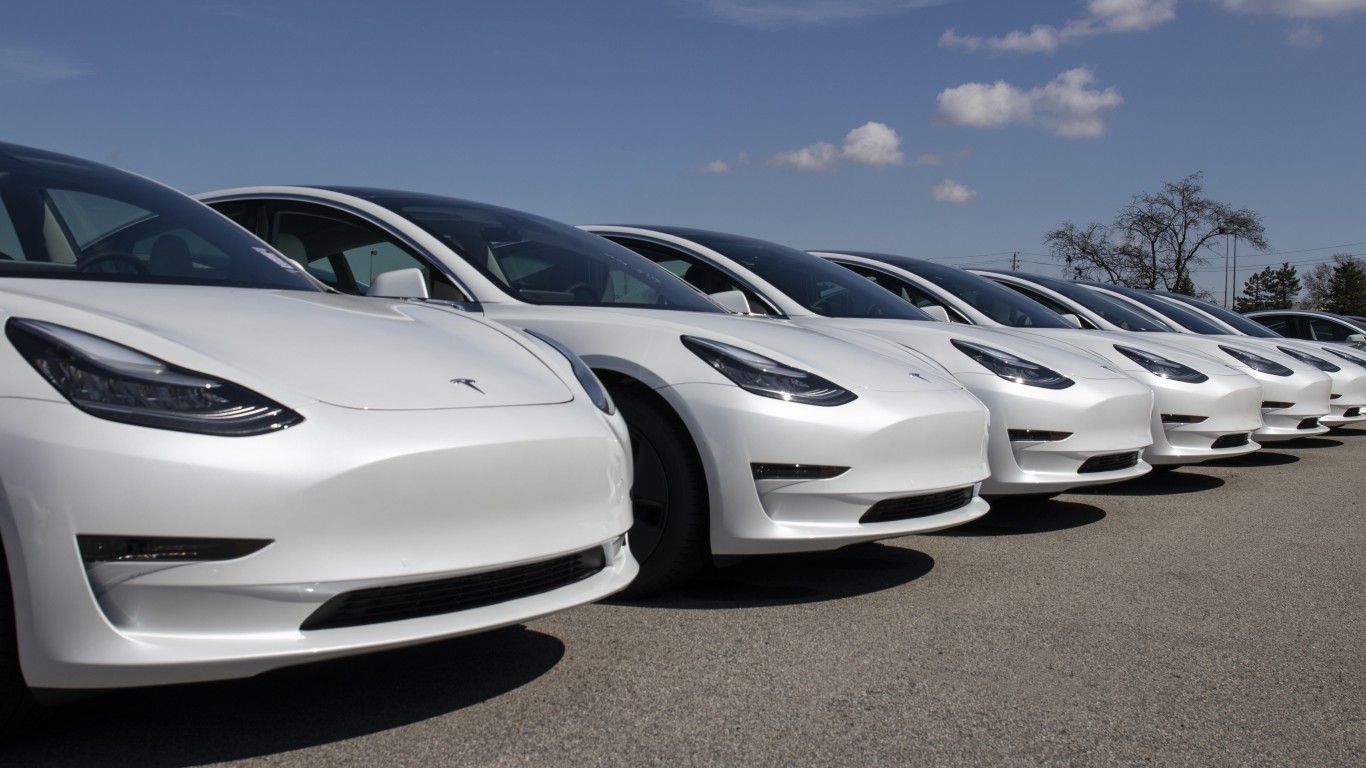Owning a car for many years can be considered a sign of brand loyalty. The car is well made, or perhaps it retains its value better than other vehicles. Each of those factors should help the reputation of the car maker. On the other hand, the longer a customer owns a car, the longer before he or she trades it in for a new one — which is what makes the manufacturer money.
Read: Nine Cars Americans Keep the Longest
Does the length of a car ownership really cut both ways? Not really, according to an analysis by 24/7 Wall St. The relationship between the length of car ownership and loyalty is weak at best.
Based on data provided by Edmunds.com, 24/7 Wall St. examined the 30 largest brands sold in the United States measured by unit volume to find the average length of car ownership for each make. The brands people hold for long periods have several characteristics in common. Most sell very few units and therefore have a small market share. Jaguar owners hold their cars for seven years, but in a good month the brand sells just 1,000 units. Similarly, Volvo and Mitsubishi — also high on our list for years of ownership — sell around 4,000 units per month.
In an interview with 24/7 Wall St., Edmunds.com analyst Jeremy Acevedo explained that shrinking market share also plays a major role in the age of traded-in vehicles. In several cases, the fact that far fewer of these vehicles are being sold today means the average age of those vehicles is necessarily going to be older. Sales of seven of the nine makes on our list declined by more than 20% between 2007 and 2011. Sales of Mitsubishi dropped by 38.6% during that period, while sales of Chrysler sank by nearly 60%.
Another common factor among these brands is the relatively older age of the car owners. Acevedo explained, “frequently, it’s just a prudent fiscal decision to hang on to your car for longer.” It is likely that this decision is especially important for seniors because “driving is less of an imperative, if they’re retired they may not be driving around as much as younger drivers.”
While the national average age for car owners is 51, the average age of a Lincoln owner is 60. Of course, parent Ford (NYSE: F) would like to bring that down. Buick owners are not that much younger, at 59 years old. Jaguar, formerly owned by Ford, and Chrysler owners are about 55 years old.
Some correlations are clear but hard to explain. Surprisingly, longer ownership appeared to be related to lower vehicle quality. The ratings of six of the nine vehicles on our list were well below the industry average in the JD Power 2012 Vehicle Dependability Survey. The study measures problems experienced during the past 12 months by original owners of three-year-old vehicles (2009 model-year). In fact, Chrysler, Dodge, Infiniti and Jaguar were at the very bottom of the list.
Perhaps as a result of poor vehicle quality, drivers who own vehicles for a long period often switch makes when the cars are traded in. While 49% of people who turned in cars in the United States traded them in for the same brand, owners of seven cars on our list did so less often, JD Power customer retention data show. Less than 40% of Buick, Dodge, Chrysler, Volvo and Jaguar owners traded in their cars for the same make.
Taken together, the data create a puzzle. That may be because the car brands that people have owned for six or seven years are very different from those same brands today. Volvo is very nearly gone altogether, having withered since it was sold by Ford. Virtually every car in the Lincoln line is different from the ones it made seven years ago. Chrysler and its Dodge division have a new owner, as does Jaguar. Many of these brands and their new parents have launched cars to bring in younger buyers.
Based on data provided by Edmunds.com, 24/7 Wall St. identified the nine car makes whose owners held them six years or more before trading them in, measured as of October 2012. We also reviewed year-over-year sales and market share data as of October 2012, as well as the average number of days vehicles are in dealer inventory before they are sold during September 2012, all provided by Edmunds.com. And we considered the average age of car buyers by make from Polk, as well as customer retention and vehicle dependability data from JD Power and Associates.
These are the nine cars Americans drive the longest.
9. Dodge
> Average age when turned in: 6.00 years (tied for 8th highest)
> Change from previous year: 9.2% (10th most)
> Market share: 3.7% (8th highest)
> Average buyer age: 50 years old
Drivers are keeping their Dodges longer than they previously did. The average age of a Dodge that was turned in last month was six years old, up from 5.5 years old in October 2011. Sales of Dodge are also climbing. Chrysler, Dodge’s parent company, sold 40,611 Dodges in October, up from 33,734 in October 2011. Chrysler has been extensively promoting its new Dodge Dart, which went on sale in June and was Dodge’s first compact car since the Neon. Although sales of the Dart were initially hurt because Dodge first shipped out cars with manual transmissions, sales of the Dart picked up by August. Customer retention for Dodge is just 21%, the third-lowest rate of all makes measured and well below the industry average of 49%.
8. Chrysler
> Average age when turned in: 6.00 years (tied for 8th highest)
> Change from previous year: 3.4% (12th least)
> Market share: 2.0% (16th highest)
> Average buyer age: 55 years old
In the past 12 months, Chrysler has sold just over 300,000 cars, trailing other Chrysler Group brands, such as Dodge and Jeep. The average age of a traded-in Chrysler vehicle in October 2012 was six years, up from 5.8 years in October 2011. Chrysler vehicles are, according to J.D. Power and Associates, the least dependable vehicles of any major manufacturer, having the most mechanical problems per vehicles sold. Chrysler tends to skew towards older consumers. The average owner of a Chrysler is 55-years old, the third-oldest among nonluxury makes.
Also Read: Automakers That Will Abandon The U.S.
7. Ford
> Average age when turned in: 6.02 years
> Change from previous year: 2.2% (9th least)
> Market share: 14.9% (the highest)
> Average buyer age: 52 years old
Ford owners hold on to their cars for an average of over six years before trading it in. The make is the nation’s most popular, with a nearly 15% share of the American car market and over 162,000 car sales in October alone. As of September it took dealers an average of just 50 days to sell a Ford, below the industry average of 61 days. Once Ford owners do trade in their models at the dealer, they are more likely than not to get another Ford. In January, J.D. Power and Associates reported Ford had a 60% customer retention rate, tied with Honda Motor Co. Ltd. (NYSE: HMC) for the second highest among all makes behind Hyundai.
6. Infiniti
> Average age when turned in: 6.10 years
> Change from previous year: 7.2% (13th most)
> Market share: 0.8% (13th lowest)
> Average buyer age: 50 years old
The average age of an Infiniti traded in last month was 6.1 years. This was up from 5.7 years for the average Infiniti turned in at the same time last year, when it was ranked ninth oldest. Infiniti sales increased by 27.6% between October 2011 and October 2012. However, Infiniti vehicles are not that popular in the first place — the brand’s market share is just 0.8%. And Infiniti’s 46% customer retention, while far from the worst, is lower than the industry average retention of 49%. The Infiniti FX has the sixth best resale value of any car, according to Kelley Blue Book. The resale value after 36 months is 58% of the original value, while the resale value after 60 months is 44%.
5. Lincoln
> Average age when turned in: 6.79 years
> Change from previous year: 10.1% (9th most)
> Market share: 0.5% (10th lowest)
> Average buyer age: 60 years old
Lincoln is Ford’s luxury car brand, although its sales trail those of Cadillac and Lexus, the upscale brands owned by General Motors Co. (NYSE: GM) and Toyota Motor Corp. (NYSE: TM), respectively. In the past 12 months, Lincoln has sold just 83,742 cars, while Cadillac has sold nearly 145,000 cars and Lexus sold 235,000. Lincoln’s demographic has aged considerably in the last few years. According to Polk, the average Lincoln buyer was 60 years old last year, older than the average buyer of any other make, and five years older than the average Lincoln buyer in 2007. Getting a Lincoln off the lot is especially hard for car dealers, who require an average of 102 days to sell a car — longer than all makes except GMC.
4. Mitsubishi
> Average age when turned in: 6.92 years (tied for 3rd highest)
> Change from previous year: 10.7% (8th most)
> Market share: 0.4% (8th lowest)
> Average buyer age: 48 years old
Mitsubishi is struggling terribly as a brand and has done so in the past 12 months. The Japanese automaker sold fewer than 4,000 units in October in the United States, down 9.1% compared to last October. The brand has one of the highest rates of complaints per units sold, as well as the eighth worst retention rate among major brands. Just one in three people who traded in a Mitsubishi in 2012 opted to get another car of the same make. The average time it took a dealer to sell a Mitsubishi in September was 99 days, longer than every brand but GMC and Lincoln. Mitsubishi cars take longer to sell, and owners are holding on to them longer as well. The average age of a Mitsubishi traded in October 2011, was 6.2 years. In October 2012, it was nearly seven years.
Also Read: The 10 Best-Selling Hybrid Cars
3. Buick
> Average age when turned in: 6.92 years (tied for 3rd highest)
> Change from previous year: 4.0% (16th most)
> Market share: 1.2% (16th lowest)
> Average buyer age: 59 years old
Buick is General Motors’ worst-selling brand. The car manufacturer sold only 13,384 vehicles in October, or just 6.8% of GM’s total unit sales. Still, sales were up 14.5% that month compared to October 2011. Customer retention for the Buick make is also one of the lowest, with 62% of those who traded in a Buick in 2011 opting for a different make. The average Buick buyer is 59-years old, older than the average buyer of any other brand except Lincoln. However, according to Polk, Buick was alone among makes in lowering the average age of its customers, which fell from an average of 62-years old in 2007.
2. Jaguar
> Average age when turned in: 7.00 years
> Change from previous year: -0.3% (7th least)
> Market share: 0.1% (2nd lowest)
> Average buyer age: 55 years old
Along with Volvo, Jaguar is the only other make to have an average age of at least seven years when it was turned in last month. Once those cars are turned in though, consumers are not so quick to buy a new one. Only 31% of Jaguar buyers end up buying another one, below the 49% industry average. Very few Jaguars are are being bought — only 699 Jaguars were sold in October 2012, down 41.3% from October 2011. Although Jaguars often are regarded as the pinnacle of luxury vehicles, according to a recent annual survey by Consumer Reports, the car performed the worst based on subscriber experiences.
1. Volvo
> Average age when turned in: 7.05 years
> Change from previous year: 2.8% (10th least)
> Market share: 0.4% (9th lowest)
> Average buyer age: 51 years old
Volvo has struggled significantly in recent years, and currently has just a 0.4% market share, worse than makes such as Scion and MINI. In 2010, Ford dumped Volvo, selling the brand to China’s Zhejiang Geely Holding Group. Despite Volvo’s traditional reputation for safety — five models currently have top safety pick ratings from the Insurance Institute for Highway Safety — owners are largely unsatisfied. According to J.D. Power and Associates, only 30% of Volvo owners purchase a new vehicle from Volvo when trading in their old car, one of the worst retention rates in the automotive industry. The make has become a tough sell, and dealers now need an average of 76 days to move Volvos off their lots — more than the 61-day industry average.
Douglas A. McIntyre, Michael B. Sauter, Alexander E.M. Hess and Samuel Weigley
Also Read: The 10 Worst-Paying States for Women
Want to Retire Early? Start Here (Sponsor)
Want retirement to come a few years earlier than you’d planned? Or are you ready to retire now, but want an extra set of eyes on your finances?
Now you can speak with up to 3 financial experts in your area for FREE. By simply clicking here you can begin to match with financial professionals who can help you build your plan to retire early. And the best part? The first conversation with them is free.
Click here to match with up to 3 financial pros who would be excited to help you make financial decisions.
Thank you for reading! Have some feedback for us?
Contact the 24/7 Wall St. editorial team.



